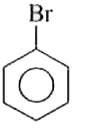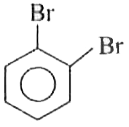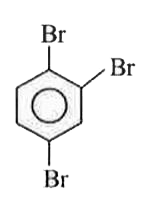Identify X, Y and Z in the following reactions :
(a) C6H5NH2NaNO2−−−−→HClXCuBr−−→HBrYNaOH−−−−−−−−→623 K, pressureZ
(b) C6H6Cl2.FeCl3−−−−−→XCuCN−−−→Ydil.HCl−−−−→H2OZ
(c) C6H5N+2Cl−KI−−→warmXCu−−→Y
To identify X, Y, and Z in the given reactions, we will analyze each reaction step by step.
Reaction (a):
1. Starting Material: Aniline (C₆H₅NH₂) reacts with HCl and NaNO₂.
- Reaction: Aniline undergoes diazotization in the presence of HCl and NaNO₂, forming diazonium chloride.
- Product (X): C₆H₅N₂Cl (Benzene diazonium chloride).
2. Next Step: The diazonium salt (X) reacts with HBr and CuBr.
- Reaction: The diazonium group (N₂Cl) is replaced by a bromine atom (Br) in a reaction known as Sandmeyer reaction.
- Product (Y): C₆H₅Br (Bromobenzene).
3. Final Step: Bromobenzene (Y) reacts with NaOH at 623 K.
- Reaction: The bromine atom is replaced by a hydroxyl group (OH) through nucleophilic substitution.
- Product (Z): C₆H₅OH (Phenol).
Summary for Reaction (a):
- X: C₆H₅N₂Cl (Benzene diazonium chloride)
- Y: C₆H₅Br (Bromobenzene)
- Z: C₆H₅OH (Phenol)
---
Reaction (b):
1. Starting Material: Benzene (C₆H₆) reacts with Cl₂ in the presence of FeCl₃.
- Reaction: This is a halogenation reaction where chlorine substitutes a hydrogen atom in benzene.
- Product (X): C₆H₅Cl (Chlorobenzene).
2. Next Step: Chlorobenzene (X) reacts with CuCN.
- Reaction: The chlorine atom is replaced by a cyanide group (CN) in another Sandmeyer reaction.
- Product (Y): C₆H₅CN (Benzonitrile).
3. Final Step: Benzonitrile (Y) undergoes hydrolysis with dilute HCl and water.
- Reaction: The nitrile group (CN) is converted to a carboxylic acid (COOH).
- Product (Z): C₆H₅COOH (Benzoic acid).
Summary for Reaction (b):
- X: C₆H₅Cl (Chlorobenzene)
- Y: C₆H₅CN (Benzonitrile)
- Z: C₆H₅COOH (Benzoic acid)
---
Reaction (c):
1. Starting Material: Benzene diazonium chloride (C₆H₅N₂Cl) reacts with KI (potassium iodide) when warmed.
- Reaction: The diazonium group is replaced by iodine (I) in a nucleophilic substitution reaction.
- Product (X): C₆H₅I (Iodobenzene).
2. Next Step: Iodobenzene (X) reacts with Cu.
- Reaction: This leads to a coupling reaction, forming biphenyl.
- Product (Y): C₆H₄ (Diphenyl).
Summary for Reaction (c):
- X: C₆H₅I (Iodobenzene)
- Y: C₁₄H₁₄ (Diphenyl)
---
Final Summary of All Reactions:
- Reaction (a):
- X: C₆H₅N₂Cl
- Y: C₆H₅Br
- Z: C₆H₅OH
- Reaction (b):
- X: C₆H₅Cl
- Y: C₆H₅CN
- Z: C₆H₅COOH
- Reaction (c):
- X: C₆H₅I
- Y: C₁₄H₁₄
1. Starting Material: Aniline (C₆H₅NH₂) reacts with HCl and NaNO₂.
- Reaction: Aniline undergoes diazotization in the presence of HCl and NaNO₂, forming diazonium chloride.
- Product (X): C₆H₅N₂Cl (Benzene diazonium chloride).
- Reaction: The diazonium group (N₂Cl) is replaced by a bromine atom (Br) in a reaction known as Sandmeyer reaction.
- Product (Y): C₆H₅Br (Bromobenzene).
- Reaction: The bromine atom is replaced by a hydroxyl group (OH) through nucleophilic substitution.
- Product (Z): C₆H₅OH (Phenol).
- X: C₆H₅N₂Cl (Benzene diazonium chloride)
- Y: C₆H₅Br (Bromobenzene)
- Z: C₆H₅OH (Phenol)
1. Starting Material: Benzene (C₆H₆) reacts with Cl₂ in the presence of FeCl₃.
- Reaction: This is a halogenation reaction where chlorine substitutes a hydrogen atom in benzene.
- Product (X): C₆H₅Cl (Chlorobenzene).
- Reaction: The chlorine atom is replaced by a cyanide group (CN) in another Sandmeyer reaction.
- Product (Y): C₆H₅CN (Benzonitrile).
- Reaction: The nitrile group (CN) is converted to a carboxylic acid (COOH).
- Product (Z): C₆H₅COOH (Benzoic acid).
- X: C₆H₅Cl (Chlorobenzene)
- Y: C₆H₅CN (Benzonitrile)
- Z: C₆H₅COOH (Benzoic acid)
1. Starting Material: Benzene diazonium chloride (C₆H₅N₂Cl) reacts with KI (potassium iodide) when warmed.
- Reaction: The diazonium group is replaced by iodine (I) in a nucleophilic substitution reaction.
- Product (X): C₆H₅I (Iodobenzene).
- Reaction: This leads to a coupling reaction, forming biphenyl.
- Product (Y): C₆H₄ (Diphenyl).
- X: C₆H₅I (Iodobenzene)
- Y: C₁₄H₁₄ (Diphenyl)
- Reaction (a):
- X: C₆H₅N₂Cl
- Y: C₆H₅Br
- Z: C₆H₅OH
- X: C₆H₅Cl
- Y: C₆H₅CN
- Z: C₆H₅COOH
- X: C₆H₅I
- Y: C₁₄H₁₄
Topper's Solved these Questions
- BOOK - MODERN PUBLICATIONCHAPTER - HALOALKANES AND HALOARENESEXERCISE - CONCEPTUAL QUESTIONS25videos
HALOALKANES AND HALOARENES
- BOOK - MODERN PUBLICATIONCHAPTER - HALOALKANES AND HALOARENESEXERCISE - NCERT In-text Questions9videos
HALOALKANES AND HALOARENES
- BOOK - MODERN PUBLICATIONCHAPTER - HALOALKANES AND HALOARENESEXERCISE - UNIT PRACTICE TEST11videos
HALOALKANES AND HALOARENES
- BOOK - MODERN PUBLICATIONCHAPTER - GENERAL PRINCIPLES AND PROCESSES OF ISOLATION OF ELEMENTSEXERCISE - COMPETION FILE (Integer Type Numerical Value Type Questions)5videos
GENERAL PRINCIPLES AND PROCESSES OF ISOLATION OF ELEMENTS
- BOOK - MODERN PUBLICATIONCHAPTER - ORGANIC COMPOUNDS CONTAINING NITROGEN EXERCISE - UNIT PRACTICE TEST5videos
ORGANIC COMPOUNDS CONTAINING NITROGEN
Similar Questions
Identify X, Y and Z in the following reactions :
(a) C6H5NH2NaNO2−−−−→HClXCuBr−−→HBrY−−−−−−−−→623 K, pressureZ
(b) C6H6Cl2.FeCl3−−−−−→XCuCN−−−→Ydil.HCl−−−−→Z
(c) C6H5N+2Cl−KI−−→warmXCu−−→YView SolutionIdentify X, Y and Z in the following reaction :
C6H5NH2NaNO2/HCl−−−−−−−−−−→0−5∘CXH2O/H+−−−−−−−−→WarmYZn−−−−−→HeatZ.View Solution
Knowledge Check
- Question 1 - Select One
Identify y in the following reaction,
C6H5NH2NaNO2/HCl−−−−−−−→(280K)XCuBr/HBr−−−−−−→YA B
B C
C D
D
- Question 2 - Select One
Identify Y in the reaction,
C6H5NH2NaNO2/HCl−−−−−−−→273KXH2O−−−−−−−→dil. H2SO4YAC6H5N2ClBC6H5OHCC6H5NHOHDC6H6 - Question 3 - Select One
Identify Y in the following reaction, C6H5NH2NaNO2/HCl−−−−−−−→280KXCuBr/HBr−−−−−−→Y
A B
B C
C D
D
Identify X, Y and Z in the following reactions:
(a) C6H6Cl2−−→AlCl3Xaq.NaOH−−−−−−−→575K,300atmYH+,H2O−−−−−→Z
(b) C6H5NH2NaNO2.HCl−−−−−−−→273KXH+,H2O−−−−−→WarmYZn−−→HeatZView SolutionIdentify 'C' in the following sequence :
C6H5NH2NaNO2+HCl−−−−−−−−→273KACuCN−−−→BLiAIH4−−−−→CView SolutionIn the following sequence of reactions, B is
C6H6Cl2−−−→FeCl3ANa−−→BView SolutionIn the following sequence of reactions, B is
C6H6Cl2−−−→FeCl3ANa−−→BView SolutionC6H5−NH2NaNO2/HCl−−−−−−−→0∘CACuCl2/HCl−−−−−−−→B, is
View Solution

